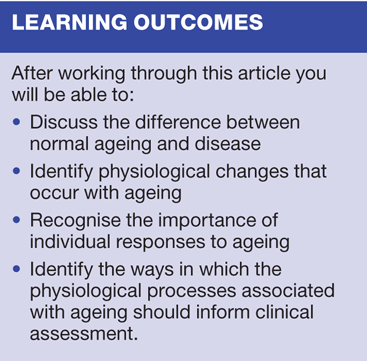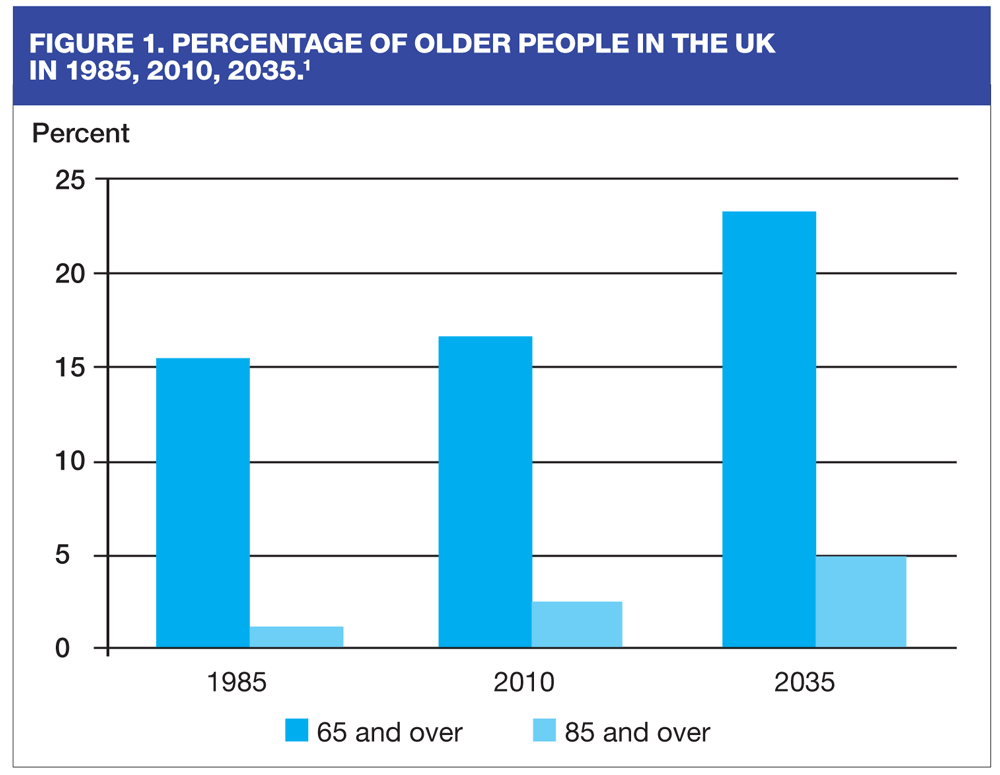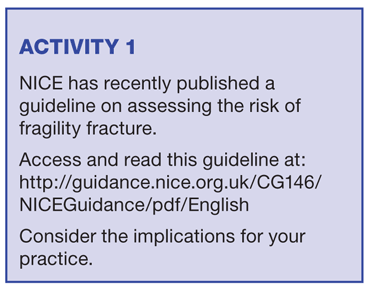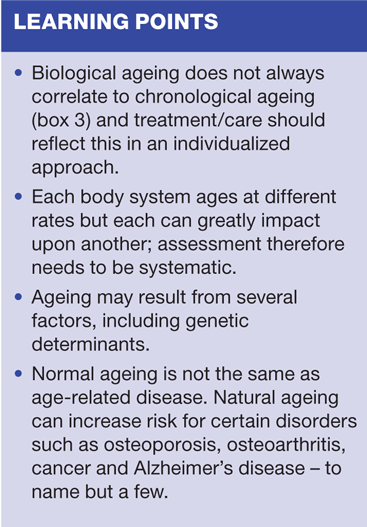The Physiology of Ageing
James Ennis
James Ennis
PA-R, PGDip, PGCE, BSc (Hons)
Senior lecturer and lead human anatomist, University of Wolverhampton.
This, the first of a two-part series, looks at the physiology of the ageing process and its relevance for the health and well-being of elderly people
The percentage of the population aged 65 years and over increased from 15% to 17% between 1985 and 2012 (an increase of 1.7 million people).1 By 2035 it is projected that people 65 years and over will make up 23% of the total population.(Figure 1) While 65 years is an arbitrary number, rather than a significant milestone in the ageing process, these numbers and future projections confirm that we are living in an ageing society. The impact of this, on individuals and care services, will be profound.
Older people are the main users of adult health services. The older patient is more likely to have multiple and complex needs and may also have a multitude of co-morbidities that are chronic in nature, and 90% of patients seen by community nurses are elderly.2 Much of their care is aimed at health promotion, maintaining an active, healthy lifestyle and supporting independence.3 (Figure 2) In order to fully address the needs of older patients, a holistic approach, that appreciates physiological deterioration as well as psychosocial support, is needed. Clinical support rests on the clinician’s ability to understand physiology so that they can advise, monitor, provide information and help with medications.
Chronological ageing is inevitable. Physiological ageing is, in contrast, a modifiable continuum. It represents an accumulation, not only of stressors, such as free radicals and lifestyle factors, but also inherent mechanisms for dealing with such stressors, including our genetic predisposition. Physiological ageing is an entirely individual process. As time takes its toll on our tissues and organs, our genes and gender, as well as our lifestyle, will determine – to some extent – how we will age.
TERMINOLOGY
Senescence
Ageing results in declining homeostatic efficiency. This is called ‘senescence’ and is a natural part of the human life cycle.4 Physiological decline begins during the late 20s and continues throughout a life cycle. (Table 1) Our compensatory mechanisms, or physiological ‘reserves’, mean that this decline has little effect earlier in life. However as our ‘reserve’ declines our capacity to maintain homeostasis declines with it.
Apoptosis
This is a mechanism of programmed cell death. Again, this is a normal part of the life cycle and is the means of eliminating unwanted cells in order to maintain homeostasis. Excessive apoptotic activity may result in unwanted cell death. It is believed that this can contribute to Alzheimer’s disease, Parkinson’s disease and stroke.5 Too little apoptotic activity may result in an ‘over-growth’ of unwanted cells which may contribute to mutated cell growth and cancer.
Discovery of the mechanisms of apoptosis could have major implications, both for our understanding of the ageing process and for how we treat age related disease.
Mitochondrial signalling
This term describes the pathways of communication, at cellular level, between the nucleus and the mitochondria – the intracellular organelles that are the cell’s ‘powerhouse’.6 These pathways play an important role in cell survival and death and are implicated in normal ageing, age related diseases and other pathology.
There is increasing interest in these signalling pathways and their potential for future therapeutic interventions,4 and there is a need for further research into the link between mitochondrial signalling, apoptosis, the ageing process and disease.7
A SYSTEMATIC APPROACH
Thinking about ageing in terms of systems can help you develop ways of assessing people in clinical practice. It may be helpful to think about systems from ’top to toe’.
Sensory organs
As part of the ageing process our sensory organs become less sensitive and less able to receive and respond to stimuli. Hearing and vision are the most dramatically affected organs but all sensory organs are affected to some degree.
Vision During the natural ageing process people generally develop long sightedness. This is due to the decline in elasticity of the lens, decreasing its ability to accommodate and focus incoming light. Vision related falls are common amongst the elderly.8
Hearing Some form of hearing loss, due to declining numbers of sensory nerve cells in the ear, is to be expected as we age. Along with age-related decline in the musculoskeletal system, ageing in this system can present particular problems with balance and stability.
Musculoskeletal system
Muscle Decreased muscle bulk, and loss of muscle mass and strength can lead to problems with stability, confounding difficulties with mobility and subsequently adversely affecting an individual’s confidence. Causative factors include increased fat and collagen deposits within the muscle itself. Age-related muscle weakness and changes in balance or gait (instability) may sometimes be misinterpreted as a neurological deficit.
Bone Bone mineral density decreases. This can lead to progressive skeletal conditions, such as osteoporosis, which predisposes people to fractures. Older individuals should be encouraged to take regular exercise, include weight bearing exercise and exercise that exerts stretching and pulling forces on long bones, in order to help sustain bone mineral density and reduce fracture risk.9
Ageing is associated with an increased prevalence of osteoarthritis and intervertebral disc shortening, leading to the normal physiological change of decrease in stature and stooped posture.
Skin and hair Decreased elastin and increased collagen results in rigidity and thinning. Skin integrity is affected by the ageing process and ‘thinning’ may make the skin more prone to tearing and damage.
Neurological system
Brain Neurons are damaged by free radicals. Decreases in the myelin sheath causes slowing of the conduction of electrical impulses in older neurons. Neurotransmitter release also slows so that synaptic transmission rates decrease. The end result is decreased reflexes, decreased mobility and poorer coordination.
Accumulation of protein tangles (TAU) can alter neuronal functioning; beta amyloid protein deposition gives rise to Alzheimer’s disease, with subsequent loss of cognitive function.
Cardiovascular system
Heart A normal aspect of ageing is loss of muscle mass in the heart. There is a slight shrinkage in the myocardium, even in those without cardiovascular disease, which may cause decreased contractility and, therefore, pumping ability of the heart. A decrease in compensatory mechanisms leaves the cardiovascular system more vulnerable to pathology with age.
In contrast, in those older individuals with cardiovascular disease, the myocardium may increase (hypertrophy).
Blood vessels Decreased elastin fibres within blood vessels can cause stiffening of the vascular wall. The increased presence of cholesterol plaques can lead to narrowing of vessels and coronary artery disease, although the progress of this can be delayed by modifying lifestyle factors, including diet, exercise and smoking. These deteriorations in blood transport can all result in an increased resting blood pressure and hypertension.
Respiratory system
As a person ages there can be both structural and functional changes to the respiratory system. Loss of vertebral height, the increased likelihood of osteoporosis and advancing kyphosis may restrict chest expansion. Thoracic kyphosis and a reduction in chest wall mobility can result in ventilation changes. Loss of elastin further affects the lungs ability to expand, reducing vital capacity.
Breakdown of alveolar walls causes decreased surface area for gas exchange. This may result in a decline in oxygen saturation.
Physiological changes in the respiratory system with age can increase risk of pulmonary infections such as pneumonia and influenza.10
Renal system
Declining numbers of nephrons result in decreased filtration and glomerular filtration rate (GFR).
Medication relevance The elderly use more drugs than any other age group11 and declining renal function can therefore have implications for medication reviews, raising issues over tolerance to side effects, as well as concordance. Renal elimination of medications decreases with age but varies substantially from person to person.
As well as a decrease in GFR there is a change in tubular function. Excretion of medications is slower due to a reduction in renal clearance. Elderly patients are therefore more susceptible to the effects of nephrotoxic drugs. NSAIDs are particularly hazardous in patients with cardiac disease and pose risk of renal damage in those already prescribed an ACE inhibitor. Drugs with a narrow therapeutic margin and potentially serious side effects that are cleared through the kidneys, e.g. digoxin, will also need to be used with caution and monitored carefully.
Immune system
T and B cells are lymphocytes with a key role in the immune system and their numbers and activity decrease with age. This contributes to increased susceptibility to infection.
The influenza vaccination is offered annually to those aged 65 and over due to this increased risk.12 However, some evidence suggests that, although vaccinations are important, their altered effectiveness and ability to last longer may be a result of age related decline in immunity.13
The incidence of autoimmune disease, such as rheumatoid arthritis, increases with increasing age. Decreased DNA repair mechanisms no longer ‘fix’ genetic changes so the immune system attacks old cells.
Gastrointestinal tract
There is a breakdown of mucus glands in both stomach and intestine and a decrease in pancreatic secretions.
As we age our calorific requirements decrease. By age 50, basal metabolic rates (BMR) are approximately 80%-85% of that in childhood.8 Weight increase in middle age may present you with an opportunity, through patient education, to promote a healthier lifestyle, including healthy eating and physical activity, ahead of old age.
Medication relevance There may be decreased drug absorption, due to a reduction of gastric acid secretion and decreased gastrointestinal motility, although this may have little clinical relevance. Constipation, however, is a common complaint in the older patient, and it is important to be aware of medications that could be confounding the problem, e.g. co-codamol.
The normal, age-related, physiological changes to the body’s systems are summarised in Table 2.
CLINICAL CONSIDERATIONS
The amount of clinical support required can vary greatly from one individual to another, reflecting the subjectivity of ageing and age-related diseases. Below are some generic principles to bear in mind when dealing with the older patient:
- Co-morbidities and multiple pathology – may exist as separate and confounding factors with disease processes across a number of systems. Be aware of the acute-on-chronic presentation and how each may impinge on the other.
- Multitude of issues – search for the origin of presentation as one problem may have several causes. Presentations may be complicated and multi-factorial.14 Several causes should be treated collectively for greater benefit.
- Non-specific presentations – some are more common in the elderly. For example confusion,15 incontinence, falls and immobility. Any disease may present with vague signs and symptoms such as those described. Be aware of the patient that does not present with ‘typical’ signs and symptoms (e.g. a myocardial infarction without chest pain).16
- Impaired metabolism and excretion of medication – less tolerance to side effects and reduced GFR may mean that doses need lowering. Be aware of toxicity in the older patient.
- Delayed treatment can be a ‘killer’ – decreased compensatory mechanisms (loss of physiological ‘reserve’) and complications are common.
- Increased recovery times – due to impairment in homeostatic mechanisms and immune response affecting repair mechanisms.
- Social factors – quality of life and its appreciation; mobility and care packages are central to improving recovery and repair.
CONCLUSION
The rate at which physiological deterioration declines due to ageing varies greatly amongst individuals, but virtually every body system will eventually deteriorate in structure and function.
There is an association of certain disorders and the ageing process of the body systems, both individually and collaboratively; for example, sensory organs (visual impairment) plus musculoskeletal (osteoporosis) equals increased likelihood of falls and fracture.
Environmental influences – such as lifestyle, diet and physical activity – on the ageing process have prompted public health campaigns and directed patient education over the last decade. Our understanding of the influence of genetic predisposition on the ageing process is still evolving and may in turn affect the way we care for the elderly and treat age related illnesses.
For now, there are some key points to bear in mind:
- Old age is associated with disease but does NOT necessarily cause it.
- Any deterioration is due to a treatable cause until proven otherwise.
- Ageing is individual and subjective.
- Age alone is a poor predictor of outcome.
SELF ASSESSMENT
1. Why do people become long-sighted as they age?
2. True or False? Swimming is good exercise for preventing loss of bone mineral density.
3. What effect does thoracic kyphosis have on the respiratory system?
4. True or False? The incidence of autoimmune disease decreases with age?
5. What does apoptosis mean?
6. What is the effect of reduced apoptosis?
7. What percentage of the population are predicted to be over the age of 65 by 2035?
a) 23%
b) 30%
c) 17%
8. By how much would you expect muscle capacity to have declined by the age of 85 years?
a) 60%
b) 50%
c) 40%
9. What does the term senescence mean?
10. At what age does physiological decline generally begin?
a) 30 years
b) 25 years
c) 35 years
SELF ASSESSMENT ANSWERS
1. The lens of the eye loses elasticity and is less able to accommodate and focus incoming light.
2. False. Swimming is good aerobic exercise and improves general fitness, but is non-weight bearing.
3. It reduces chest wall mobility, impairing ventilation and reducing the vital capacity.
4. False. Decreased DNA repair mechanisms no longer ‘fix’ genetic changes so that the immune system attacks old cells.
5. Programmed cell death.
6. Reduced apoptosis may result in an ‘overgrowth’ of cells and may contribute to increased mutated cell growth and cancer.
7. 23%
8. 50%
9. Declining homeostatic efficiency.
10. 25 years.
REFERENCES
1. Office for National Statistics. Population Ageing in the United Kingdom, its Constituent Countries and the European Union. March 2012 http://www.ons.gov.uk/ons/rel/mortality-ageing/focus-on-older-people/population-ageing-in-the-united-kingdom-and-europe/rpt-age-uk-eu.html
2. Department of Health. National Service Framework for Older People: A Report of Progress and Future Challenges. DH 2003 http://www.dh.gov.uk/en/Publicationsandstatistics/Publications/PublicationsPolicyAndGuidance/DH_4008132
3. Department of Health. Generic Choice Model for Long Term Conditions. DH 2007 available at http://www.dh.gov.uk/en/Publicationsandstatistics/Publications/PublicationsPolicyAndGuidance/DH_081
4. Clancy J, McVicar A. Physiology and anatomy for nurses and healthcare practitioners; a homeostatic approach. Third Edition. UK. Hachette. 2009
5. Sherwood L. Essentials of physiology. Fourth Edition. Brooks/Cole, Cengage Learning. 2012,2006
6. Butow RA, Avadhani NG. Mitochondrial signalling: the retrograde response review. Molecular Cell 2004;14:1-15
7. Lakshminarasimhan M, Steegborn C. Emerging mitochondrial signalling mechanisms in physiology, ageing processes, and as drug targets. Experimental Gerontology 2011;46:174-177
8. Department of Health. National Service Framework for Older People. DH. 2001 http://www.dh.gov.uk/en/Publicationsandstatistics/Publications/PublicationsPolicyAndGuidance/DH_4003066
9. National Osteoporosis Foundation. Clinician’s guide to prevention and treatment of osteoporosis. 2010 http://www.nof.org/hcp/practice/practice-and-clinical-guidelines/clinicians-guide
10. Department of Health. Key vaccine information: seasonal flu. DH. 2011 http://webarchive.nationalarchives.gov.uk/+/www.dh.gov.uk/en/Publichealth/Immunisation/Keyvaccineinformation/DH_104070
11. Merck Manual. Drug therapy in the elderly. 2009
12. Department of Health. Immunisation against infectious disease – ‘The Green Book’. DH 2012 http://immunisation.dh.gov.uk/category/the-green-book/
13. MedlinePlus. Ageing changes in immunity. http://www.nlm.nih.gov/medlineplus/ency/article/004008.htm
14. National Institute for Health and Clinical Excellence. Clinical practice guideline for the assessment and prevention of falls in older people. Clinical Guideline 21. 2004 http://www.nice.org.uk/nicemedia/pdf/CG021fullguideline.pdf
15. National Institute for Health and Clinical Excellence. Delirium: diagnosis, prevention and management. Clinical Guideline 103. 2010 http://www.nice.org.uk/nicemedia/live/13060/49909/49909.pdf
16. Longmore M, Wilkinson I, Tumezei T, Cheung CK. Oxford handbook of clinical medicine. Seventh Edition. Oxford University Press. 2007








